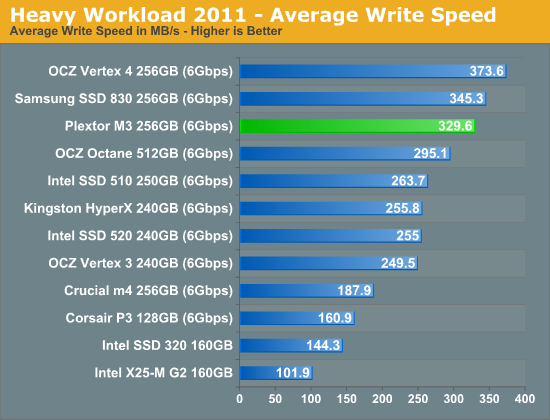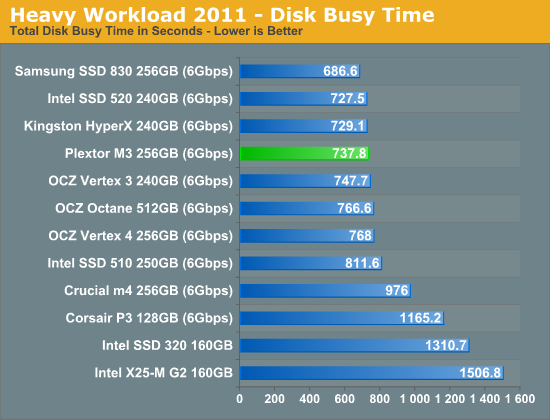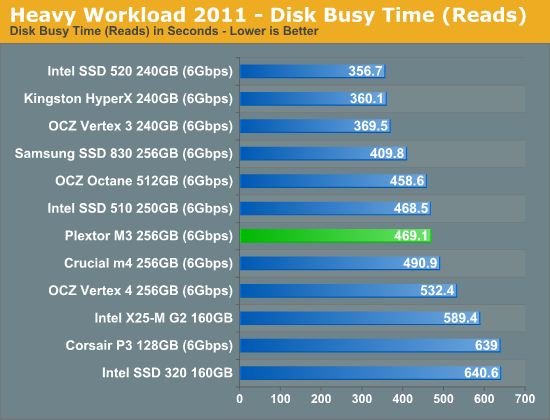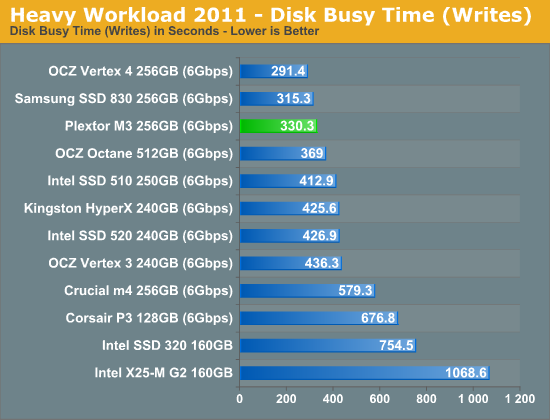The Plextor M3 (256GB) Review
by Kristian Vättö on April 5, 2012 3:05 AM ESTAnandTech Storage Bench 2011
Last year we introduced our AnandTech Storage Bench, a suite of benchmarks that took traces of real OS/application usage and played them back in a repeatable manner. Anand assembled the traces out of frustration with the majority of what we have today in terms of SSD benchmarks.
Although the AnandTech Storage Bench tests did a good job of characterizing SSD performance, they weren't stressful enough. All of the tests performed less than 10GB of reads/writes and typically involved only 4GB of writes specifically. That's not even enough exceed the spare area on most SSDs. Most canned SSD benchmarks don't even come close to writing a single gigabyte of data, but that doesn't mean that simply writing 4GB is acceptable.
Originally we kept the benchmarks short enough that they wouldn't be a burden to run (~30 minutes) but long enough that they were representative of what a power user might do with their system. Later, however, we created what we refer to as the Mother of All SSD Benchmarks (MOASB). Rather than only writing 4GB of data to the drive, this benchmark writes 106.32GB. This represents the load you'd put on a drive after nearly two weeks of constant usage. And it takes a long time to run.
1) The MOASB, officially called AnandTech Storage Bench 2011—Heavy Workload, mainly focuses on the times when your I/O activity is the highest. There is a lot of downloading and application installing that happens during the course of this test. Our thinking was that it's during application installs, file copies, downloading, and multitasking with all of this that you can really notice performance differences between drives.
2) We tried to cover as many bases as possible with the software incorporated into this test. There's a lot of photo editing in Photoshop, HTML editing in Dreamweaver, web browsing, game playing/level loading (Starcraft II and WoW are both a part of the test), as well as general use stuff (application installing, virus scanning). We included a large amount of email downloading, document creation, and editing as well. To top it all off we even use Visual Studio 2008 to build Chromium during the test.
The test has 2,168,893 read operations and 1,783,447 write operations. The IO breakdown is as follows:
| AnandTech Storage Bench 2011—Heavy Workload IO Breakdown | ||||
| IO Size | % of Total | |||
| 4KB | 28% | |||
| 16KB | 10% | |||
| 32KB | 10% | |||
| 64KB | 4% | |||
Only 42% of all operations are sequential; the rest ranges from pseudo to fully random (with most falling in the pseudo-random category). Average queue depth is 4.625 IOs, with 59% of operations taking place in an IO queue of 1.
Many of you have asked for a better way to really characterize performance. Simply looking at IOPS doesn't really say much. As a result we're going to be presenting Storage Bench 2011 data in a slightly different way. We'll have performance represented as Average MB/s, with higher numbers being better. At the same time we'll be reporting how long the SSD was busy while running this test. These disk busy graphs will show you exactly how much time was shaved off by using a faster drive vs. a slower one during the course of this test. Finally, we will also break out performance into reads, writes, and combined. The reason we do this is to help balance out the fact that this test is unusually write intensive, which can often hide the benefits of a drive with good read performance.
There's also a new light workload for 2011. This is a far more reasonable, typical every day use case benchmark. It has lots of web browsing, photo editing (but with a greater focus on photo consumption), video playback, as well as some application installs and gaming. This test isn't nearly as write intensive as the MOASB but it's still multiple times more write intensive than what we were running last year.
We don't believe that these two benchmarks alone are enough to characterize the performance of a drive, but hopefully along with the rest of our tests they will help provide a better idea. The testbed for Storage Bench 2011 has changed as well. We're now using a Sandy Bridge platform with full 6Gbps support for these tests.
AnandTech Storage Bench 2011—Heavy Workload
We'll start out by looking at average data rate throughout our new heavy workload test:

Samsung SSD 830 continues to dominate our Heavy suite but in both read and write, but the M3 is the fastest Marvell based SSD and delivers a result 32% faster than the Crucial m4. Overall the M3 is on-par with SandForce—it does worse in read speed but takes that back in write speed.


The next three charts just represent the same data, but in a different manner. Instead of looking at average data rate, we're looking at how long the disk was busy for during this entire test. Note that disk busy time excludes any and all idles; this is just how long the SSD was busy doing something:













113 Comments
View All Comments
ecuador - Thursday, April 5, 2012 - link
He he, I read the article before the update and it sounded to me like it was written by a 15 year old! Little known Plextor... lolGood thing you updated, but in general when commenting on a company for an article do a little google search in case you are missing something ;)
JarredWalton - Thursday, April 5, 2012 - link
Just because you can google a company to read about them (Kristian had already done that -- note the paragraph about them being a subsidiary of Shinano Kenshi Corporation), it doesn't mean everyone out there is familiar with the company. I sort of laughed when Kristian said he hadn't head their name until a few months back, but then, there were plenty of companies I wouldn't have known a thing about when I was 17.Kristian Vättö - Thursday, April 5, 2012 - link
My point is that Plextor has not been in the spotlight for years. I was just surprised when the name came up because I seriously had not heard much about them. I consider myself to be pretty updated when it comes to the SSD front but I still had not heard the name Plextor until a few months back. That's why I wrote what I wrote. In SSD context, Plextor can be a new name for many, or at least it was for me :-)I admit that I did not know about their success in the ODD market in the 90s but then again, I was still spoon-fed at that time :-P
christoi - Thursday, April 5, 2012 - link
On the second page, on the test setup it says "Intel Core i7-2500K." I assume it's an i5 from the 3.3ghz clock?Kristian Vättö - Thursday, April 5, 2012 - link
Yeah, it's an i5. Thanks for the heads up, fixed it :-)BolleY2K - Thursday, April 5, 2012 - link
...are the 5 year warranty and the included version of Acronis True Image, which allows the user to easily clone his existing OS drive to the SSD.These two things are not included in the packages of most other SSDs on the market and in my opinion add to the value of the M3 package, so should be mentioned in the review.
Btw. I own the 128GB and am very pleased with it - easy installation (also due to the included software), good performance and entirely issue free so far. :-)
Kristian Vättö - Thursday, April 5, 2012 - link
At least my version did not come with Acronis True Image. The included clone utility is called Echo and is made by NTI. Not that it matters as the tool worked flawlessly when I copied my boot drive to the M3 :-)BolleY2K - Thursday, April 5, 2012 - link
Ah ok - I live in germany and over here you get Acronis. Well, as long as it works, it doesn´t matter how it is called I guess. ;-)I still think these 2 goodies should be mentioned and also kept in mind while discussing the price of the M3. Also the QA of these drives is very good - plextor states 20 hours of testing for every single SSD they ship and a RMA rate of 0,5%.
ckryan - Thursday, April 5, 2012 - link
I picked up a Plextor M3P, and here you get NTI.I went to try it out, and it did not play nice with Acronis which was on my system. After settting it up, the system reboots and loads a linux partition to do the copy operation... well, it didn't work, and then I couldn't get past the linux boot on subsequent restarts.
I could just revert to a clone from a week prior on another SSD, but not everybody has it like that.
The NTI Echo probably works quite well if you don't already have another clone suite installed like acronis.
The M3P is totally bitchin' though.
Jocelyn - Thursday, April 5, 2012 - link
I got my 256GB M3 for $290 in February and the 128GB often hits $150-$160. Anyway, Thanks for finally doing a review on the M3 and I <3 Toshiba Toggle Nand!!